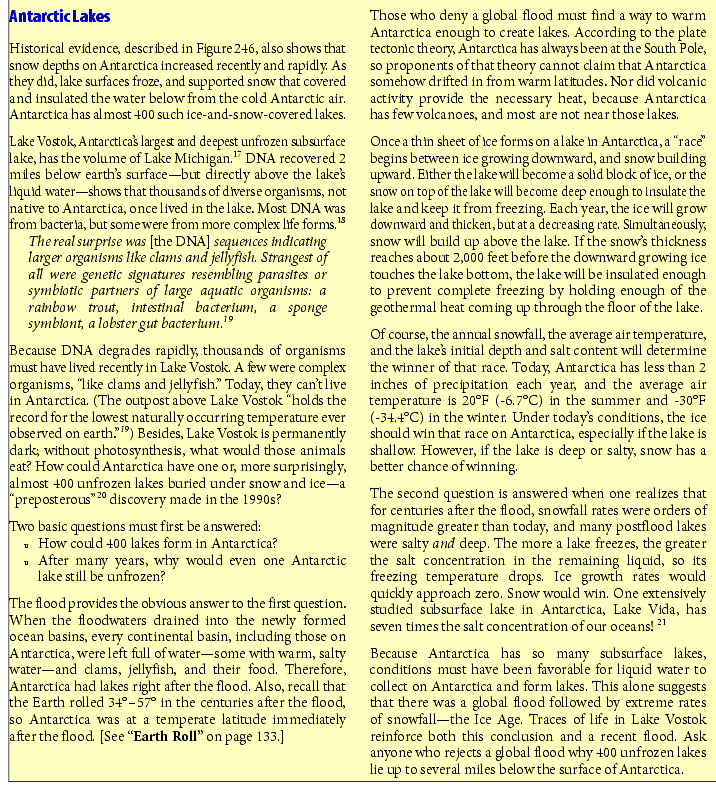Why Is Global Warming Occurring? What Can Be Done about It?
Global warming—an emotionally charged social, political, economic, and ecological issue—is occurring. Most who conclude that man is the primary cause of global warming also believe the Earth is billions of years old, and are alarmed that man is ruining a billion-year-old Earth in just a few decades. Nevertheless, global warming is extremely serious.
We frequently hear that humans are raising global temperatures by producing too much carbon dioxide (CO2), a greenhouse gas. That is only part of the problem.1 Many other factors are involved. Increases in atmospheric CO2 began recently—at the start of the industrial revolution (in about 1750). Global warming actually began at the end of the ice age—thousands of years earlier! Therefore, man-made CO2 is not the main cause of global warming. Besides, water vapor in the atmosphere is a more potent and abundant greenhouse gas. The amount of water vapor, and its warming effects, increase as temperatures rise.
If not reversed, global warming will damage world economies, raise sea levels,2 and increasingly produce extreme weather (tornadoes, hurricanes, fires, and local floods). Poorer countries will suffer the most. Thousands of researchers with conflicting solutions to the problem are competing for funds. However, before trillions of dollars are spent trying to stop global warming, all its causes should be clearly understood.
The Sun’s slightly variable output accounts for some of earth’s temperature fluctuations, but the dangerous warming trend, seen over centuries, will probably continue for surprising reasons. We should first understand why the Earth has so much ice—7 million cubic miles, of which 88% is in Antarctica and 10% in Greenland. If all that ice melts, sea level will rise at least 200 feet with disastrous results.2
Just a 10-meter (33-foot) rise in sea level would displace 10% of the world’s population and submerge New Orleans, New York City, London, much of Florida, and small islands. large parts of North America’s east coast, northern Europe, Bangladesh, Siberia, and China, would also be flooded. A 200-foot rise in sea level would displace 20% of the world’s population.3
The global flood produced the unique conditions that for over a century caused the Ice Age: cold continents and warm oceans. [See pages 111–147.] Crashing hydroplates at the end of the flood crushed and thickened continents and buckled up Earth’s major mountains, making continents temporarily higher and, consequently colder than they are today. Also, after the flood, oceans were warmer than today, primarily because so much magma erupted onto the floor of the Pacific Ocean. Even today, extremely hot supercritical water, jetting up from under the ocean floor, is warming the oceans. [See Figure 56 on page 125.] Warm oceans produced extensive evaporation and precipitation, which on the cold continents resulted in extreme snowfall rates that built up glaciers. Heavy cloud cover, dust and light-reflecting aerosols from volcanoes, also a consequence of the flood, further cooled the continents.
Large temperature differences between cold continents and warm oceans generated powerful wind systems that quickly carried moist air up and over continents where much of the water vapor cooled, condensed, and fell as snow. Each winter’s glacial advances were followed by summer’s glacial retreats. These yearly cycles left marks that some mistakenly associate with multiple ice ages (4–30 ice ages, depending on location).
For a few centuries after the flood, oceans gradually cooled and the continents and their mountains, that thickened during the compression event, slowly sank into the mantle. Both changes steadily reduced the heavy snowfall toward today’s rates. Eventually, ice depths peaked. With decreasing snow cover, less of the Sun’s radiation was reflected off ice sheets and back into space.4 Therefore, the Sun has been increasingly warming the Earth and melting ice. This first positive-feedback cycle will continue unless steps are taken to reverse the cycle.
A second consequence of earth’s ice melting is rising sea levels which shift mass toward the equator, slightly increasing earth’s polar moment of inertia, and slowing earth’s spin rate.5 (This is one reason clocks on earth are stopped periodically for one second to let the slowing earth catch up.) Therefore, days are becoming slightly longer and warmer on average and nights slightly colder. The net effect of all this is more melting ice and global warming—a second positive feedback cycle.
Those who claim that man is the sole cause of global warming have not addressed the key question: Why did the Earth once have so much ice? Apart from the worldwide flood, explanations for the Ice Age have fatal scientific problems—something most earth scientists understand. Since the peak of the Ice Age, melting ice has raised sea level about 400 feet;6 man did not cause that rise. Without some major change, sea level will rise at least 10 inches in the next 100 years and almost 200 feet in the next few thousand years.7 This steady rise will be apparent to all in a few decades.
Yes, atmospheric CO2 is increasing, but much of the increase is due to warming oceans, which then release some of the huge amounts of CO2 dissolved in them. That, in turn, increases warming—a third positive-feedback cycle and more global warming. (Oceans contain 50 times more CO2 than the atmosphere!) Simply stated, CO2 increases warm the oceans which then produce even more CO2 increases.
Warming oceans produced a fourth positive feedback cycle by pumping more moisture into the atmosphere. Since water vapor is the most abundant and potent greenhouse gas, that additional water vapor warms the atmosphere which then produces more water vapor.
Forest fires produce CO2 directly and heat the atmosphere, which then makes forest fires more likely—a fifth positive feedback cycle. As the Earth warms, decay processes within the soil increase, and release more CO2 —a sixth positive feedback cycle.
What Can Be Done? If the earth can begin to cool, all six positive feedback cycles and global warming will reverse. Many are proposing geoengineering: massive, deliberate interventions in Earth's natural systems to counteract global warming. Those schemes would probably pollute the biosphere and risk other unintended consequences.

Before the flood, there were no major ice sheets, so losing glaciers is not the problem. Earth’s preflood vegetation was lush, as evidenced by today’s abundant coal, oil, and methane deposits. But even without major ice sheets to cool the preflood earth, that lush vegetation compensated and made Earth the comfortable habitat God intended. We can move toward those conditions safely by merely reestablishing and conserving, to the extent possible, earth’s forests.8 Within a few decades, reforestation and reducing deforestation would sequester considerable carbon rather than letting it overheat the Earth. Cooling oceans would no longer rise or release their dissolved CO2 .9 Annual damage from storms will steadily decrease from the current few hundred billion dollars each year.
Currently, we are losing 25 million acres of forests a year, but plenty of fertile land is available for planting new forests.10 Yes, conserving forests and reforestation will be expensive, but far less than the billions of dollars of storm damage each year—not to mention the loss of lives in storms, fires, and hurricanes. Suicide rates have also been shown to increase with increases in temperature.11
Photosynthesis. In summary, the key is photosynthesis, which uses the sun’s energy to split water into useful hydrogen and oxygen rather than letting that solar energy heat the earth. Today, photosynthesis on earth absorbs three times the energy generated by human civilization.12
So, by increasing photosynthesis on earth by one-third, as much additional energy will be absorbed by plants as is released by all human activity. Global warming will end, and the four harmful positive feedback cycles mentioned above will reverse: (1) glaciers will stabilize, (2) oceans will stop rising, (3) our atmosphere’s main greenhouse gases (CO2 and water vapor) will steadily decline, and (4) forest fires costing billions of dollars each year will diminish. We must begin immediately.
Those who express opinions on the cause of global warming usually look at its effects today and assume its cause—without considering preflood conditions. The hydroplate explanation, which accounts for many other features of the earth and solar system, makes a more comprehensive understanding of global warming, not just from effect back to cause, but also from cause directly to effect. We can have greater confidence in our conclusion when, after considering all the data, including the Ice Age and its causes, the issue is seen identically in both directions: cause-to-effect and effect-to-cause.
